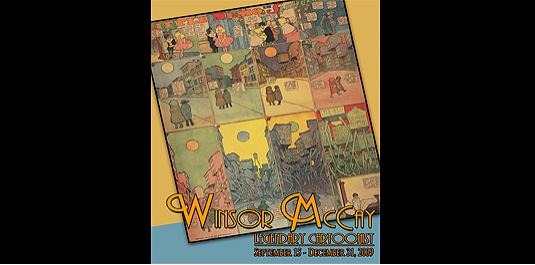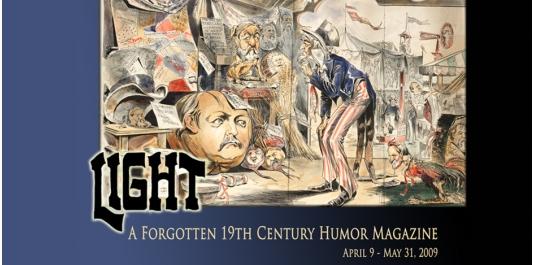Past Exhibits
 Drawn On Stone: Political Prints from the 1830s and 1840s March 19, 2010 - December 19, 2010
Drawn On Stone: Political Prints from the 1830s and 1840s March 19, 2010 - December 19, 2010 Drawn on Stone explores American political cartooning during the tumultuous Jacksonian era. The exhibition features thirty rare satirical lithographs recently acquired by the Cartoon Research Library with help from the William J. Studer endowment. This extraordinary collection illustrates the surge in the creation and distribution of political cartoon broadsides made possible by the relative ease and speed of the new print-making process of lithography. Several cartoons not found in other major print collections are included.
 Winsor McCay: Legendary Cartoonist September 15, 2009 - December 31, 2009
Winsor McCay: Legendary Cartoonist September 15, 2009 - December 31, 2009 Winsor McCay was an unusually prolific cartoonist. More than thirty comic strip titles and ten animated films are credited to him. The decade between 1903 and 1913 was his most creative period. His biographer, John Canemaker, states, “…when the American comic strip was in its infancy, McCay became the first master of the form with two unsurpassed works of genius, Dream of the Rarebit Fiend…and Little Nemo in Slumberland.” In addition, McCay was an important pioneer animator and a popular vaudeville performer.
- From Yellow Kid to Conan: American Cartoons from the International Museum of Cartoon Art Collection June 28, 2009 - August 7, 2009
As the old saw goes, timing is everything.
Mort Walker had a dream of a bona fide museum that exhibited original cartoon art. Hard work and ingenuity turned a mansion into a museum in 1974. More hard work and ingenuity turned a concrete castle into a second home for their museum. Its third incarnation as the International Museum of Cartoon Art (IMCA) in Boca Raton, Florida, seemed to be the dream come true, but economic realities intervened. Despite the challenges during these years, the museum’s collection, thousands of priceless original cartoons from around the world as well as books and artifacts related to all of the genres of cartoon art, grew and flourished.
Concurrent with the museum’s development, a cartoon library was growing at The Ohio State University. It began in two classrooms off the back hallway of the Journalism Building in 1977. Soon it expanded to three classrooms and officially became part of the University Libraries. When the three classrooms were filled a dozen years later, the library moved into much larger space. In subsequent years, additions to its holdings expanded the collection so much that the use of off-site storage was required.
By 2006 it was clear that provisions had to be made for additional space for the Cartoon Library and a possible lead donor stepped forward. After two feasibility studies, university officials decided that the cartoon library should have a new home, complete with museum-quality galleries, in Sullivant Hall, a historic building at the gateway to campus. The opportunity to merge the International Museum of Cartoon Art (IMCA) Collection with the library presented itself because of the additional storage space and galleries that will be available in Sullivant Hall. We are grateful that Mort Walker and the IMCA board accepted our invitation and agreed to transfer its treasures to The Ohio State University. In recognition of its expanded responsibility to exhibit original cartoon art, the name of the library was changed to Cartoon Library and Museum in December 2008. It is fitting that one of the galleries in Sullivant Hall will be named in honor of Mort Walker.
 Hogarth and Beyond: Global Cartoons from the International Museum of Cartoon Art Collection June 10, 2009 - August 31, 2009
Hogarth and Beyond: Global Cartoons from the International Museum of Cartoon Art Collection June 10, 2009 - August 31, 2009 The Reading Room Gallery
June 10, 2009 – August 31, 2009
As the old saw goes, timing is everything.
Mort Walker had a dream of a bona fide museum that exhibited original cartoon art. Hard work and ingenuity turned a mansion into a museum in 1974. More hard work and ingenuity turned a concrete castle into a second home for their museum. Its third incarnation as the International Museum of Cartoon Art (IMCA) in Boca Raton, Florida, seemed to be the dream come true, but economic realities intervened. Despite the challenges during these years, the museum’s collection, thousands of priceless original cartoons from around the world as well as books and artifacts related to all of the genres of cartoon art, grew and flourished.
Concurrent with the museum’s development, a cartoon library was growing at The Ohio State University. It began in two classrooms off the back hallway of the Journalism Building in 1977. Soon it expanded to three classrooms and officialy became part of the University Libraries. When the three classrooms were filled a dozen years later, the library moved into much larger space. In subsequent years, additions to its holdings expanded the collection so much that the use of off-site storage was required.
By 2006 it was clear that provisions had to be made for additional space for the cartoon library and a possible lead donor stepped forward. After two feasibility studies, university officials decided that the cartoon library should have a new home, complete with museum-quality galleries, in Sullivant Hall, a historic building at the gateway to campus. The opportunity to merge the International Museum of Cartoon Art (IMCA) Collection with the library presented itself because of the additional storage space and galleries that will be available in Sullivant Hall. We are grateful that Mort Walker and the IMCA board accepted our invitation and agreed to transfer its treasures to The Ohio State University. In recognition of its expanded responsibility to exhibit original cartoon art, the name of the library was changed to Cartoon Library and Museum in December 2008. It is fitting that one of the galleries in Sullivant Hall will be named in honor of Mort Walker.
The works in this exhibit are a fraction of the many thousands of works in the IMCA Collection, which includes a wide range of cartoon art from around the world. During the museum’s years in Boca Raton, Florida, board member Jerry Robinson was especially active in building its holdings of cartoons by contemporary international cartoonists. We salute the perseverance and dedication of everyone who worked to make the International Museum of Cartoon Art a reality. The International Museum of Cartoon Art Collection, which is their legacy, will be the source of great pleasure and inspiration for decades to come.
The opening of this exhibit will be celebrated with a reception from 3:30-5:00 pm at the Hopkins Hall Gallery + Corridor in conjunction with the opening of Yellow Kid to Conan: American Cartoons from the International Museum of Cartoon Art Collection. Refreshments will be served. Free and open to the public.
 Light: A Forgotten 19th Century Humor Magazine April 9, 2009 - May 31, 2009
Light: A Forgotten 19th Century Humor Magazine April 9, 2009 - May 31, 2009 Light was by far the most important of lithographic comic weekly to be published outside of New York or San Francisco during the last quarter of the nineteenth century. It provided the first or early employment to a host of talented cartoonists, illustrators, and at least one writer who would later go on to successful careers. Those who contributed to Light included Will H. Bradley, W. W. Denslow, Frank Ladendorf, Ferand Lungren, Hy Mayer, Peter Newell, T. E. Powers, C. S. Rigby, and Horace Taylor. It also published the works of prominent New York cartoonists, such as Eugene Zimmerman and F. M. Howarth.
During its bumpy two-and-a-half year existence, the magazine’s one constant was change: it changed its name, its place of publication, its size and appearance, and its owners, editors, and chief cartoonists. It began in Columbus in March 1889 as The Owl. It changed its name to Light in June and suspended publication in September. It was revived in Chicago in February of 1890, went full-color in May, increased its page size in September, and published its final issue in June 1891.

